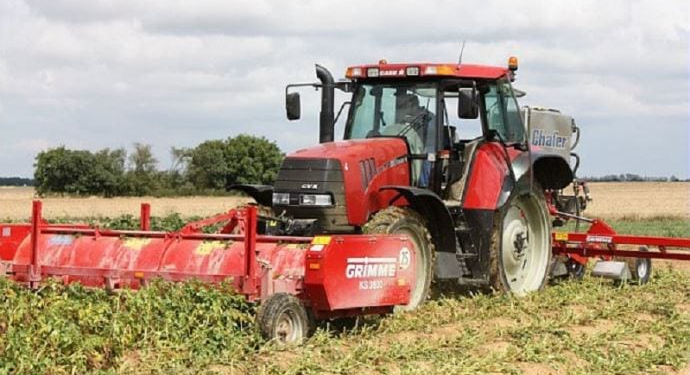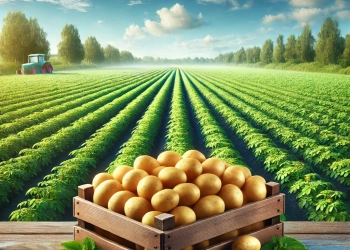Chemical, mechanical, thermal or electrical defraying…? Several solutions are available to succeed in this intervention.
The aim of the defeasing is to completely and rapidly destroy the vegetation to control the caliber, control the quality of the potato and facilitate the harvest. Unlike premium potatoes, which are harvested when tubers are immature and often “peely,” preservative potatoes must be torn off after full maturity of the epidermis to ensure proper tuber conservation. To do this, it is necessary to wait for the natural maturity of the crop or, more often than not, to proceed with a defraying when the quality of the tubers is optimal.
Chemical defraying: adapting its strategy to the development of culture
The following table shows the products available:
| Specialties | Firms | Active substances / concentration | Authorized doze / ha | maximum number of treatments | mixing restriction |
| BELOUKHA (1) | Belchim Crop Protection | Pelargonic acid (680 g / lit ) | 16 lit | 1 | no |
| GOZAI (2) | Belchim Crop Protection | Pyraflufen-ethyl (26.5 g / lit) | 0.8 lit | no | |
| SORCERER / WARRIOR (3) DOLBY (4) | Philagro | Pyraflufen-ethyl (26.5 g / lit) | 0.8 lit | 2 | no |
| SPOTLIGHT | F.M.S. | Carfentrazone-ethyl (60 g / lit ) | 1 lit | 2 | no |
(2) Sold as Gozaï Max Pack (0.8 | Gozai + 1.6 | Beloukha)
(3) To be used with an extemporaneous adjuvant such as mineral or vegetable oil
(4) Sold as a Pack (0.8 Sorcerer + 1.6 Brazier Adiuvant)
Specialties that can be used for potato unfalering for the 2020 season (©Arvalis-Plant Institute)
For early varieties that tend to have few bales and mature quickly, a single defecating passage or grinding of senescent fanes may sometimes suffice. A two-application or even three-application treatment program is the most common strategy. The first treatment aims to quickly destroy the foliage and initiate senescence; the second, 5 to 7 days later, allows the destruction of the stems while limiting the leafy regrowth. With the disappearance of defensant products, a third pass may be necessary depending on the development of the crop and the year.
For each product, it is also necessary to respect its specific application conditions such as the possibility of mixing, with a fungicide for example, or the time before harvest.
Mechanical grinding to reduce the share of the chemical
“100% chemical” defying is currently the most widely used method. But the strategy of grinding potato bales, in addition to a chemical defray, is attracting more and more interest. In this context, the application of Beloukha, a biocontrol product for potato defeaning, can find its place. However, it is a product that requires good implementation conditions (water volume, climatic conditions,.) for a good result.
Shredders that adapt
Crushing bales is an effective operation that instantly removes more than 75% of the vegetation. But the construction rate is moderate due to a speed of progress often close to 5 km/h and the width of the equipment. To increase the project rate, many manufacturers now offer 6-row models in one chassis (Grimme), two folding chassis (Baselier) or 3 2-row Front/Rear modules (AVR). The materials also adapt to different planting configurations: mounds or logs.
In addition, spraying equipment can be adapted to the shredder to perform a complementary chemical treatment simultaneously with the mechanical grinding of bales. This prevents vegetation from resuming when the intervention takes place before the first signs of vegetation mature. In addition to a front shredder, Agricult’s Loef-Does model, worn at the rear of the tractor, allows a low-volume centrifugal spray (40 to 70 l/ha) that is widespread on the surface of the mounds. For towed shredders, a rear ramp equipped with conventional nozzles allows localized treatment of the upper part of the mounds, which generally reduces the application dose by 50% with comparable efficiency. Agronomic and Grimme offer adaptations of this type.
Thermal defraying: a renewed path
Despite its high energy balance, thermal defeasing can also be an option for certified organic production or avoid chemical use, even in the event of significant vegetation development. The passage of a thermal defensor results in the destruction of the leaves in just a few hours, which provides an interesting sanitizing effect in the event of a mildew attack on the foliage for these specific specification crops.
After gas solutions initiated in the mid-1990s (Moreau, Rabaud…), Axinor has been offering equipment using rapeseed oil for its burners for more than three years. Developed to meet the needs of the Cuma Creative, this model works on 4 rows, adapting to different planting configurations, from 70 to 90 cm, thanks to sliding burners above the stainless steel oven with reinforced insulation. The speed of progress varies from 2.5 to 4 km/h depending on the leaf volume to be destroyed for oil consumption between 100 and 150 l/ha. Its two tanks with a total capacity of 650 l give it a battery life of about 5 to 6 ha (usually 5 hours) before it requires a filling.
In the south of France, the defensor Humeau works on two rows, with fuel as fuel. For nearly a decade, several groups of AB-certified plant growers have been successfully using it after a simultaneous, light frontal grinding. The workflow is lower because of the width of the work; fuel consumption and about 35 l/ha for a passage, knowing that two interventions are most often required in this context of early defling to achieve total destruction of vegetation. The thermal defrayer marks its passage through the plot after only a few minutes
Mechanical snatching of bales: a recent innovation
Mechanical snatching of bales is an open route more than twenty years ago. Oldenhuis inflatable balloon equipment was the most commercialized equipment, but it remained confined to plant cultivation in the Netherlands to achieve rapid destruction of vegetation by reducing the risk of rhizoctone contamination of tubers.
Since 2017, Rema has been offering fully automated strip hydraulic equipment, with a root-cutting organ associated with it to complete the action on the stems that are insufficiently detached from the root system. Also, this material works classically with an initial grinding of the foliage to facilitate the pinching of the stems between the strips avoiding jams. Arvalis’ 2018 assessment showed a Spotlight-like effectiveness in achieving total destruction of still immature vegetation after pre-crushing. The aggressiveness on the mounds of the Rema material is less than that of the Oldenhuis model to limit the risk of tubers discovered and at risk of greening. The observations also showed a skin holding speed of the tubers similar to the chemical solution.
Electrical deflation: a new path still being tested
Initial work in 2019 showed that Zasso’s XPower model could probably provide a new path for potato unfaving. This material electrocutes plants from an electricity generator connected to the tractor’s power grab. This electrocution causes a gradual decline in vegetation. Measurements made last year showed a significant action to achieve a good defraying of the crop with a safety on the tubers in one or two passages depending on the difficulty of defecating the plot, but also in addition to an initial mechanical grinding of the bales. Experimentation work continues this year to refine the possibilities and conditions of use of this innovative equipment.









